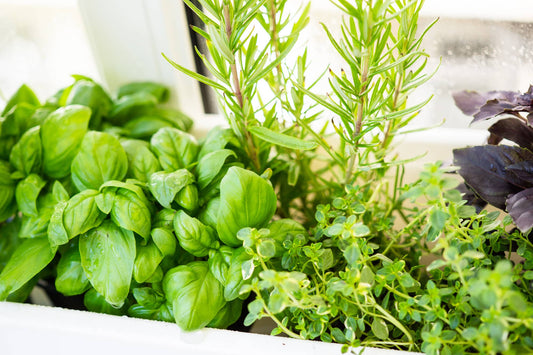Picture a lush, thriving hydroponic garden.
Now imagine it is slowly wilting away due to unseen threats…
Disease can strike even the most carefully tended hydroponic systems.
But the good news is that you can transform your garden into a fortress against pathogens with the right knowledge!
The key lies in understanding and implementing crucial prevention strategies for keeping your hydroponic garden healthy.
Ready to safeguard your hydroponic haven?
Let’s dive in!

What Are the Most Common Diseases in Hydroponics?
While hydroponic systems are less prone to diseases than soil gardens, they aren't entirely immune.
Diseases often spread through contaminated water, poor ventilation, or infected plants.
These are some of the most common diseases in hydroponics:
-
Root rot
Pathogens like Pythium can thrive in poorly oxygenated water and cause root rot. It can quickly spread through the system, causing roots to turn brown and mushy.
-
Powdery mildew
This fungal disease can appear on plant leaves as white, powdery spots. It often occurs in high humidity conditions and poor air circulation, potentially reducing photosynthesis and yield.
-
Fusarium wilt
Another fungal infection that can cause leaves to turn yellow and wilt, often starting on one side of the plant. It can survive in hydroponic systems and spread through contaminated water or equipment.
-
Botrytis
This gray mold thrives in humid environments with poor air circulation. It appears as fuzzy gray growth on leaves, stems, and fruits and can potentially cause significant crop losses.
-
Algae growth
While not a disease, algae can compete with plants for nutrients and oxygen. It appears as green slime in reservoirs and growing surfaces, potentially harboring pathogens.

5 Essential Practices to Keep Your Plants Healthy
Maintaining a thriving hydroponic garden requires more than just providing nutrients and water. It's about creating an optimal environment where your plants can flourish.
Let's dive into crucial practices that will help you cultivate a vibrant and productive hydroponic garden.
1. Maintain Cleanliness
The key to a thriving hydroponic garden lies in an often overlooked aspect: cleanliness.
To maintain a pristine hydroponic environment, follow these essential steps:
- Start by regularly sterilizing your equipment with hydrogen peroxide or a mild bleach solution.
- Clean reservoirs, trays, and tools before each planting cycle.
- Remove dead plant material promptly to prevent decay and pathogen growth.
A clean environment minimizes the risk of diseases like root rot and fungal infections.
This simple habit will go a long way in keeping your hydroponic garden healthy and disease-free!
For more detailed cleaning guidelines, check out our complete maintenance guide for your hydroponic system.
2. Monitor Water Quality
Your plants' roots are like fish - they need clean, oxygen-rich water to thrive. Follow these practices to keep the water in your hydroponic systems fresh and clean:
- Regularly test your water for pH and nutrient levels, aiming for a pH range of 5.5 to 6.5.
- Use clean, filtered water to avoid introducing contaminants.
- Change the water in your reservoir every two weeks to prevent the buildup of harmful pathogens.
- Consider using an automated monitoring system to keep track of water conditions effortlessly.
With these steps, you'll give your plants the best drink possible, helping them grow strong and healthy!

3. Ensure Proper Air Circulation
Good air circulation is also vital for preventing diseases in hydroponic systems. Stagnant air can lead to the development of mold and mildew.
- Use fans to ensure a steady flow of air around your plants.
- Consider installing an air pump to oxygenate the water and prevent root diseases like Pythium.
- Position your plants to allow adequate space between them, promoting better air movement.
You create an environment where plants can flourish and reach their full potential by orchestrating proper airflow.

4. Monitor Plant Health Regularly
What's the secret weapon of successful hydroponic gardeners? A keen eye and regular check-ups.
- Look for signs of trouble, such as yellowing leaves, spots, or unusual growth patterns, to troubleshoot quickly.
- Early detection of issues like root rot or powdery mildew allows quick intervention, preventing the spread to other plants.
- Keep a log of your observations to track any changes over time.
- Remove and quarantine any infected plants immediately to prevent contamination.
By cultivating this habit of vigilance, you'll be able to nip problems in the bud and keep your hydroponic garden thriving.
Nurture Your Green Thumb: Your Hydroponic Journey Awaits
With these essential tips in your toolkit, you're well-equipped to keep diseases at bay in your hydroponic garden.
Maintaining cleanliness, ensuring proper air circulation, and staying vigilant will create an environment where plants thrive and pathogens struggle.
Ready to explore the world of hydroponics further? Explore our high-quality systems or download our free hydroponic guide to get started!
Why Nature Tech?
- Our hydroponic systems save up to 90% more water than traditional growing methods.
- All hydroponic growing systems are designed for modern life with maximum yield, minimum effort, and endless beauty & joy.
- Our systems are made of food-safe plastics that don't contaminate the water with unhealthy compounds.
- Our compact and adaptable set-up can be used in large indoor spaces or a small balcony – wherever you choose, your plants will flourish.
- Our home-growing systems are easy to use - even for beginner gardeners!
- With our systems, your plants grow up to 3x faster than in soil, so you’ll save more time!
- We’re here to offer help every step of the way. If you need advice or have any doubts, feel free to reach out to us!




